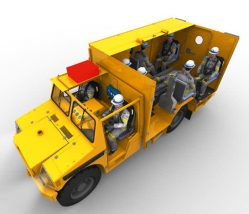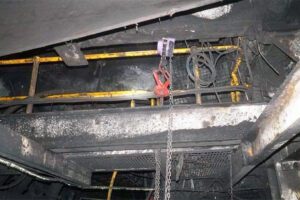A new mines rescue vehicle that has been developed specifically for use in Canadian mines could revolutionise the way teams approach a rescue. Dräger and mining vehicle manufacturer Paus have teamed up to bring the latest in rescue vehicles for mines.
The Dräger MRV9000 was first launched at MinExpo in 2016 and a custom built design has been manufactured for Goldcorp in Canada for its’ operations. The new self-contained mine rescue vehicle that allows rescuers to quickly drive drifts or to other areas of mines without exposing personnel to hazardous atmospheres. It enables an extension of the mission time for mines rescue teams by providing safe transportation closer to the incident scene.
READ RELATED CONTENT
- Global mine safety benchmark report reveals more must be done
- Underground mine fire initiates emergency response
- The beginnings of mines rescue
- Mines Rescue Events – EK Healy Cup
The new Dräger vehicle is sealed and self-contained with its own air supply. Ultimately the design of the vehicle means the mine rescuers do not have to waste their individual air supply while travelling to an accident location. This is especially important when proceeding through any area of mine gas, smoke or carbon monoxide from a fire.
The new vehicle is a four-wheel drive truck built by Paus of Germany which supplies a range of mining vehicles including flameproof versions for use in the underground coal. The vehicle cab has room for two people and has its own positive pressure air supply. The cargo area in the rear has seats for seven mine rescuers as well as room for a stretcher and patient. It, too, is equipped with its own fresh air supply.
The seats also have enough room to allow the rescuers to wear their breathing apparatus so they will be ready to act, under oxygen, once they leave the truck. The vehicle is also air conditioned, which means it can filter humidity and keep the mine rescuers from becoming overheated during their travel time.
Dräger says that both the driver’s cabin and cassette are equipped with an air purging system. This system is independent of the ambient air and provides breathing air for the onboard personnel. Once the team has exited the vehicle equipped with personal breathing protection, the air flow in MRV 9000 can be manually reduced for the remaining occupants. As a result, breathing air from the onboard cylinders can be conserved to provide additional time for the overall mission. Once the team returns to the MRV 9000 and the driver’s cabin and cassette have been successfully flushed, their individual breathing apparatuses are no longer required.
The vehicle is also equipped with a range of gas monitors that can test the mine air for any contaminants as the vehicle moves along. The truck comes equipped with front and rear thermal imaging cameras, as well.
The vehicle can be used to bring rescued miners to back to surface or to a fresh air refuge station underground.
 AMSJ understand that the vehicle is diesel powered however future versions may include a battery-electric option.
AMSJ understand that the vehicle is diesel powered however future versions may include a battery-electric option.
The diesel engine in the mines rescue vehicle should not be hindered by a lack of oxygen in an underground mine fire. During the vehicle’s development risk analysis was carried out and it was determined that in most mine fires, the oxygen in the air rarely fell below 16 per cent, which leaves enough to support combustion in a diesel engine.
More information and a current video is available on Dräger’s website.
Read more Mining Safety News














Add Comment